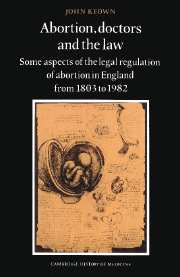 Abortion, Doctors and the Law
Abortion, Doctors and the Law Book contents
- Frontmatter
- Contents
- Table of cases
- Table of statutes
- Acknowledgements
- Introduction
- 1 The first statutory prohibition of abortion: Lord Ellenborough's Act 1803
- 2 Anti-abortion legislation 1803–1861 and medical influence thereon
- 3 Abortion in legal theory and medical practice before 1938
- 4 The medical profession and the enactment of the Abortion Act 1967
- 5 The Abortion Act 1967 and the performance of abortion by the medical profession 1968–1982
- 6 The reaction of the medical profession to proposed restriction of the law 1969–1979
- 7 A theoretical overview
- Appendices
- Notes
- Subject index
- Names index
3 - Abortion in legal theory and medical practice before 1938
Published online by Cambridge University Press: 26 October 2009
- Frontmatter
- Contents
- Table of cases
- Table of statutes
- Acknowledgements
- Introduction
- 1 The first statutory prohibition of abortion: Lord Ellenborough's Act 1803
- 2 Anti-abortion legislation 1803–1861 and medical influence thereon
- 3 Abortion in legal theory and medical practice before 1938
- 4 The medical profession and the enactment of the Abortion Act 1967
- 5 The Abortion Act 1967 and the performance of abortion by the medical profession 1968–1982
- 6 The reaction of the medical profession to proposed restriction of the law 1969–1979
- 7 A theoretical overview
- Appendices
- Notes
- Subject index
- Names index
Summary
In Chapters 1 and 2 it was suggested that the passage and shape of the anti-abortion enactments from 1803 to 1861 were influenced by regular medical practitioners who relentlessly urged the need for suppression by the law of a practice which threatened not only fetal and maternal welfare but also the interests of their profession.
However, there is reason to approach the regulars' expressions of concern for fetal life with caution. Just as it would be simplistic to assume that their condemnation of abortion was purely altruistic, so too would it be superficial to conclude that they regarded fetal life as inviolable.
Medical abortion and the law 1803–1938
On 27 April 1938 a girl of fourteen was raped. She was taken to see Dr Joan Malleson, a member of the medico-legal council of the Abortion Law Reform Association, who contacted a fellow council member, Dr Aleck Bourne, obstetric surgeon to St Mary's Hospital. He replied:
I shall be delighted to take her in at St. Mary's and curette her. I have done that before and shall not have the slightest hesitation in doing it again. I have said that the next time I have the opportunity I will write to the Attorney-General and invite him to take action.
On 31 May, the girl was taken to see Dr Bourne by her mother. A letter of consent to the proposed operation was then obtained from her father. Bourne then saw Dr Wingate, a resident obstetric officer at St Mary's and informed him of his reasons for operating, namely that the girl was under the age of consent and had been raped. On 6 June she was admitted to the hospital. A pregnancy test proved positive.
- Type
- Chapter
- Information
- Abortion, Doctors and the LawSome Aspects of the Legal Regulation of Abortion in England from 1803 to 1982, pp. 49 - 83Publisher: Cambridge University PressPrint publication year: 1988


